Small lines of code change the world
1. The world's first line of binary code in 1725
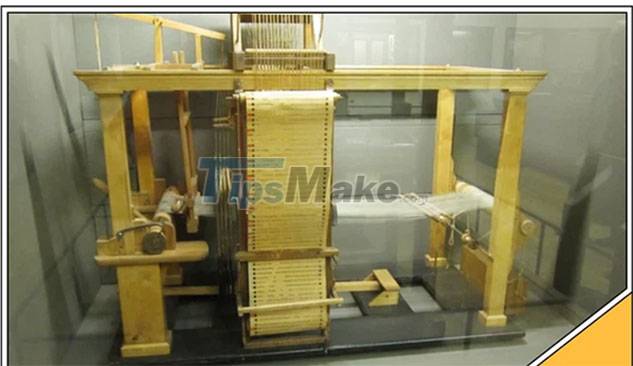
Binary programming appeared long before computers appeared. In 1725, Basile Bouchon punched a hole in the paper, the hole punched in the paper was "1" and the unpunched part was "0". He used it to control a loom he invented. This loom can weave in a pre-made pattern based on commands fed through pre-punched sheets of paper.
2. The world's first modern line of code 1948
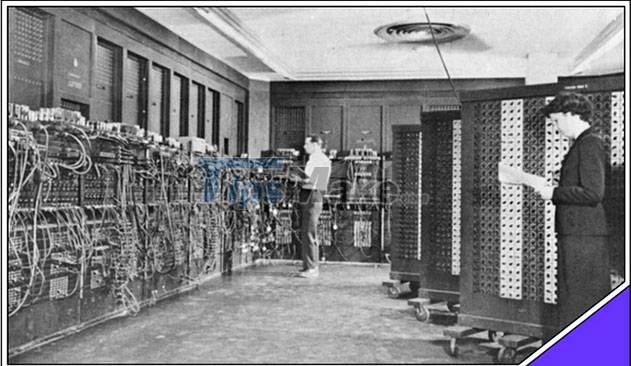
ENIAC (short for Electrical Numerical Integrator and Computer) is the world's first programmable electronic computer that appeared in 1945. ENIAC has the ability to configure each problem by wiring between its many components.
A few years later, Klára Paste von Neumann and Los Alamos lab scientist Nicholas Metropolis hooked up ENIAC to run the world's first line of modern code.
3. The World's First Video Game

In late 1961, a group of young MIT students and employees began to have access to the DEC PDP-1, the leading civilian computer at the time for $120,000 (more than $1 million today). This computer has an instruction length of up to 18-bit and uses paper tape as storage.
After 5 months, they created the first video game - Spacewar. In the game, 2 players will control space ships to dodge the gravity of a star in the middle of the screen and participate in battle. This game has inspired many generations of video games later.
4. The Beginning of Email 1965

In 1961, MIT Academy hackers created a system that allowed batches of users to log into the same computer and leave short messages to each other.
In 1965, a group of coders created a formal command system for sending, receiving, and displaying these small digital messages. And in 1971, but after the world's first spam message appeared, it was a message against the Vietnam War.
5. Bailout, the line of code that helped Apollo 11 conquer the Moon in 1969
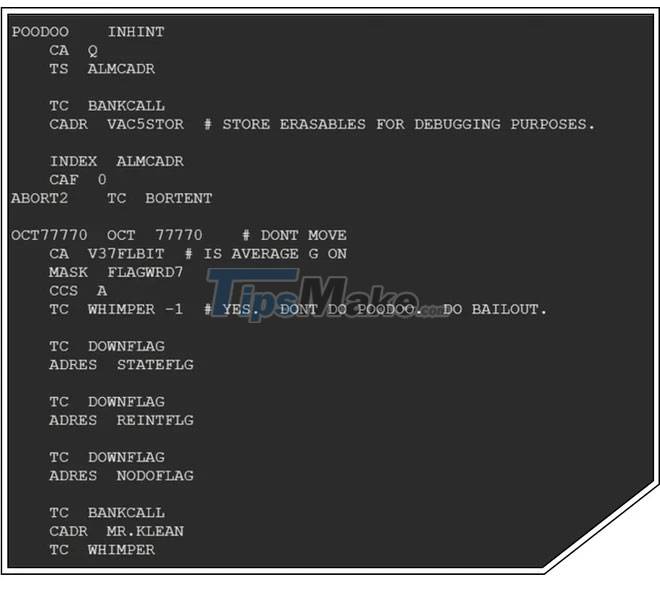
AGC, the Apollo 11 navigation computer, had computing power weaker than a greeting card today.
Because the storage space and operating power of the spacecraft's computers are limited, each task on the AGC must be carefully calculated so that it does not run out of memory. The AGC development team created BAILOUT, a line of code that can schedule less important operations so that AGC can continue to handle other important tasks. When the computer is in danger of running out of space (or overflowing), AGC will trigger BAILOUT.
When the Eagle lander was about 9km from the lunar surface, the AGC emitted a warning signal "1202" - an error indicating that the computer was about to be overloaded. At that time, the AGC triggered the BAILOUT statement. Unimportant tasks are skipped by AGC to focus on more important work that keeps the journey going.
BAILOUT then rescued AGC three more times before Neil Armstrong set foot on the Moon.
6. Hello word 1972

When learning a programming language, the first instruction you are given is to make the computer display the words "Hello, World". This statement has been around since 1972 and became famous when it appeared in the C Programming Language tutorial in 1974. And so far it has become an easy and friendly solution to help illustrate the difference. between programming languages.
7. Null String - Terminated String 1972, the worst design mistake in software history

In 1972, Dennis Ritchie decided to represent text in his new programming language called C with something called a null-terminated string. And its legacy has been with us ever since.
8. The world's first chat application Internet Rely chat in 1988

Internet Relay Chat or IRC, the first popular program that allowed people to group chat with each other. It appeared before most people knew what the internet was.
Users must type a command line like "/join #[chat channel name]" to join a certain chat channel.
To say something about yourself, you can type "/me is so tired," the chat channel will display your name with the word "so tired" next to an asterisk. This is the starting point for today's desktop chat applications and command usage.
9. Morris worm 1988
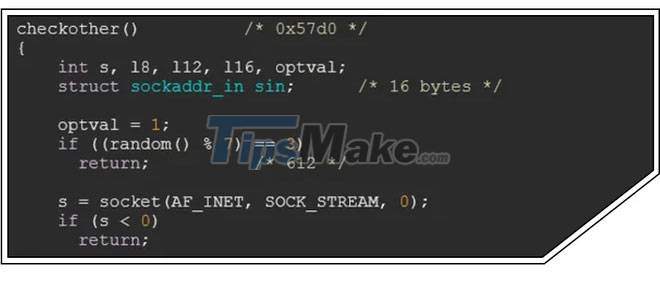
The Morris worm spread to the internet on November 2, 1988. It was affecting about 10% of the 60,000 computers that were connected to the internet at the time and caused millions of dollars in damage. The Morris worm and prompted the New York Times to mention the word "internet" for the first time.
Morris, then just a 23-year-old Cornell student, who wrote this worm was also surprised at how destructive it was. After the attack, Morris was the first person to be prosecuted under the American Computer Fraud and Abuse Act.
10. Hyperlink HTML Hyperlink 1988

Hyperlink, a short piece of code that makes the Web accessible to anyone.
11. The appearance of JPEG in 1992
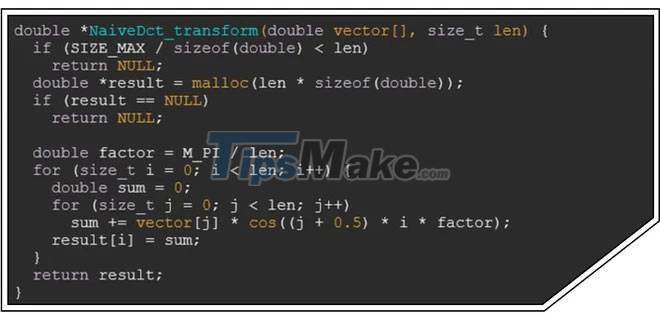
In 1992, the Joint Photographic Experts Group published the parameters of a new standard - JPEG.
JPEG takes advantage of a lossy compression format that removes some details in the image that are invisible to the human eye, so that the data of each image is smaller.
After its launch, JPEG quickly became the global standard, in part because it was royalty-free.
The lossy compression format also paved the way for the introduction of MP3 music files - an audio format that removed some data undetectable to the human ear, in 2016.
12. Mosaic Browser 1993
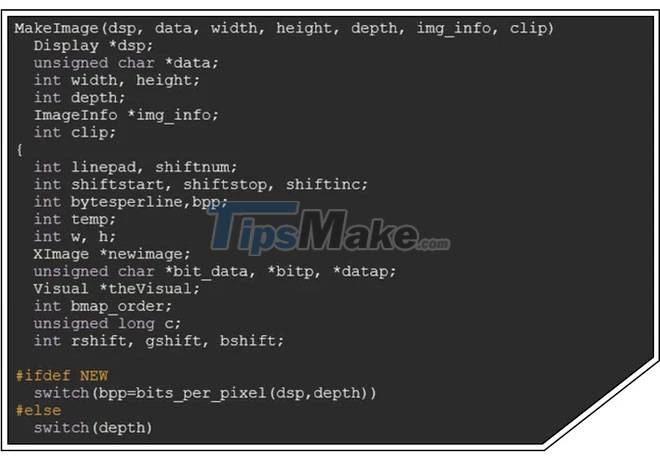
Before the appearance of the Mosaic browser, other browsers offered complex displays that forced the user to view the image in a separate window.
The Mosaic hacker group, led by Marc Andressen, created the Mosaic browser to display images and text side by side making the web look like a newspaper or a digital magazine, more user-friendly.
13. Tracking Pixels

These tiny pieces of HTML code are fundamental to the entire digital advertising industry and are central to a host of issues such as surveillance, tracking, media consolidation, and even fake news.
Initially, these 1-pixel transparent images were created to adjust the layout of the website. The companies later realized that, if they download these pixels, a cookie is downloaded that allows them to track user activity on the site. In addition, these pixels help companies see who is visiting and where they are.
14. The beginning of wikipeida in 1994

WikiWikiWeb was first introduced by Mr. Ward Cunningham as the simplest possible way to share information.
To help editors update and organize linking information between pages, Ward Cunningham used a basic markup language, including parentheses, to string words together without spaces and apostrophes around the text. To this day, this system is still widely used on wiki pages, including Wikipedia, which was launched in 2001.
15. Google's PageRank Algorithm in 1996

Before PageRank appeared, search engines only tried to find information based on whether a keyword matched a word already in the document.
Then Larry Page and Sergey Brin, the two founders of Google, created PageRank, an algorithm that ranks a website's relevance based on how many pages link to it.
This algorithm plays an important role in ranking on the internet, and laid the foundation for Google to become the technology giant it is today.
16. Bitcoin in 2008
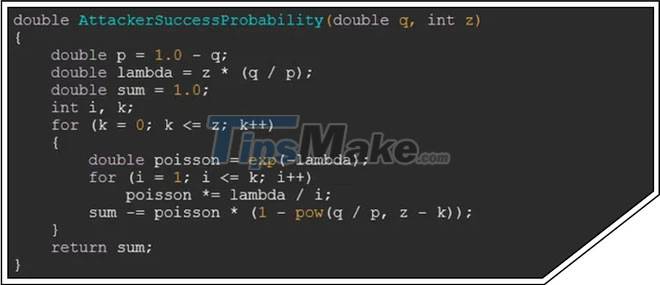
In 2008, Satoshi Nakamoto, an anonymous creator published a white paper on the launch of Bitcoin. These lines of code show that the chances of someone hacking and taking over the Bitcoin blockchain are extremely low. This has convinced the world how reliable it is.
To date, Bitcoin has paved the way for the creation of nearly 3,000 different cryptocurrencies.
17. Facebook Like Button 2009

The Facebook like button helps users show their agreement with something on this social network. However, so far, the Like button has become a tool that helps Facebook follow us everywhere on the internet and collect all data about users' web surfing habits.
You should read it
- JavaScript code to create OHLC and line chart combo chart template
- Discovered a new line of malicious Android code that steals user data on the electronic application market
- Some tricks or LINE users should know
- How to create and open folders in VS Code with Git Bash for Windows
- Summary of Cheat GTA code
- How to add or delete friends on LINE?
 Intel Alder Lake CPU conflicts with DRM software, making users unable to play games
Intel Alder Lake CPU conflicts with DRM software, making users unable to play games This new malware can take root of Android smartphones
This new malware can take root of Android smartphones Microsoft discovered a critical vulnerability on macOS
Microsoft discovered a critical vulnerability on macOS Why did Facebook change its name to META?
Why did Facebook change its name to META? Microsoft is forcing Windows 10 users to install the PC Health Check app
Microsoft is forcing Windows 10 users to install the PC Health Check app Apple confirms the existence of a series of serious vulnerabilities that can cause iPhones to be hacked
Apple confirms the existence of a series of serious vulnerabilities that can cause iPhones to be hacked